

 |
 |
 ALAIN DUCASSE - World Renowned Atelier of Gastronomy
ALAIN DUCASSE - World Renowned Atelier of Gastronomy
by Kaya Morgan
![]()
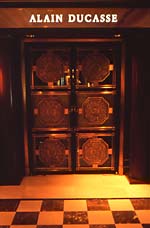 If any one man has single handedly made the greatest contribution to the every changing face of the successful restaurateur, it would undoubtedly be Alain Ducasse. From his humble beginnings in rural France to the present Ducasse internationally-renowned reputation, he never ceases to amaze our palate and entertain our senses as one of the world's greatest chefs.
If any one man has single handedly made the greatest contribution to the every changing face of the successful restaurateur, it would undoubtedly be Alain Ducasse. From his humble beginnings in rural France to the present Ducasse internationally-renowned reputation, he never ceases to amaze our palate and entertain our senses as one of the world's greatest chefs.
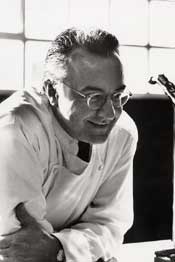 The recipient of nearly every conceivable award for his American flagship establishment in New York City — Alain Ducasse at the Essex House, located on Central Park South — the only new property ever to receive the prestigious 2002 Mobil Five-Star Award, as well as James Beard Foundation's - Best New Restaurant, a New York Times four-star review, Condé Nast Traveler's "2001 - 100 Hot Tables," as well as Bon Appetit's - "Chef of the Year 2001."
The recipient of nearly every conceivable award for his American flagship establishment in New York City — Alain Ducasse at the Essex House, located on Central Park South — the only new property ever to receive the prestigious 2002 Mobil Five-Star Award, as well as James Beard Foundation's - Best New Restaurant, a New York Times four-star review, Condé Nast Traveler's "2001 - 100 Hot Tables," as well as Bon Appetit's - "Chef of the Year 2001."
With one seating of only 65 people per night, this is the only restaurant that upon opening, required an exchange of faxed financials to accompany the request for dining reservations, as well as having a unique mineral-water sommelier. So, not to be caught unaware, it is only a bit more expensive than Ducasse's Parisian restaurant making it higher priced than the most expensive restaurant in France. Is it worth it? Anyone who can afford the luxury of dining there will resoundingly agree, yes.
 But, how did this culinary genius build his empire? Born on a quiet country farm in Castelsarrazin in the Landes region of south-western France, his family grew their own vegetables and bred a variety of animals — geese and ducks in particular. This is no doubt where Alain acquired his taste for foie gras and the fresh simple produce that makes his cooking so delectable.
But, how did this culinary genius build his empire? Born on a quiet country farm in Castelsarrazin in the Landes region of south-western France, his family grew their own vegetables and bred a variety of animals — geese and ducks in particular. This is no doubt where Alain acquired his taste for foie gras and the fresh simple produce that makes his cooking so delectable.
At age 16, Ducasse began working at the Pavillon Landais restaurant in Soustons where he followed with formal training at the Bordeaux school of Hotel and Catering. Upon completion, he made his way into Michel Guérard's restaurant in Eugénie-les-Bains, learning many of the tricks of the trade from his first mentor. He then worked at Roger Verge's Moulin de Mougins where he discovered the flavors of Provençal cooking that later became the most essential element in his own kitchens.
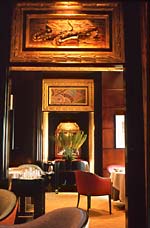 It wasn't until 1987, when Ducasse was offered the position of Chef de Cuisines at the famed luxury Hotel de Paris in Monte-Carlo which also included the management of the famed Le Louis XV restaurant that his reputation began to soar. Boasting the most prestigious guests and fashionable, elaborate parties, in 1990, it became the first hotel restaurant in history to be awarded three stars in the Michelin Guide. That began a long history of a series of successful restaurants: As manager and chef — Alain Ducasse au Plaza Athénée (Paris), 59 Poincaré (Paris); consultant and concepts for the bar & boef (Monte-Carlo), Spoon Food & Wine (London, Paris, Tokyo, Mauritius), Le Relais du Parc (Paris), and Il Cortile (Paris).
It wasn't until 1987, when Ducasse was offered the position of Chef de Cuisines at the famed luxury Hotel de Paris in Monte-Carlo which also included the management of the famed Le Louis XV restaurant that his reputation began to soar. Boasting the most prestigious guests and fashionable, elaborate parties, in 1990, it became the first hotel restaurant in history to be awarded three stars in the Michelin Guide. That began a long history of a series of successful restaurants: As manager and chef — Alain Ducasse au Plaza Athénée (Paris), 59 Poincaré (Paris); consultant and concepts for the bar & boef (Monte-Carlo), Spoon Food & Wine (London, Paris, Tokyo, Mauritius), Le Relais du Parc (Paris), and Il Cortile (Paris).
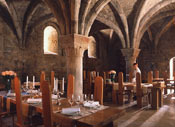 Although a chef, first and foremost, Ducasse has also partnered as a hotelier in La Bastide de Moustiers, a 12-bedroom country inn near the Verdun Gorges in Provence and L'Hostellerie de l'Abbaye de la Cella, a 10-bedroom renovated 18th century abbey situated in the heart of a cluster of architectural treasures on the edge of the Green Provence region. In 1999, he accepted the Presidency of the hotel chain "Chateaux & Hotels de France" which boasts over 500 members.
Although a chef, first and foremost, Ducasse has also partnered as a hotelier in La Bastide de Moustiers, a 12-bedroom country inn near the Verdun Gorges in Provence and L'Hostellerie de l'Abbaye de la Cella, a 10-bedroom renovated 18th century abbey situated in the heart of a cluster of architectural treasures on the edge of the Green Provence region. In 1999, he accepted the Presidency of the hotel chain "Chateaux & Hotels de France" which boasts over 500 members.
 The piece de resistance has been the creation of the Alain Ducasse Formation (Argenteuil), a state-of-the-art kitchen which develops and tests new dishes for the restaurants while serving as a training ground for new apprentices in the industry. Ducasse openly admits to his belief that a chef does not have to be monitoring the helm at all times. He prefers to train and conduct his troops to carry out his instructions with military precision. Under his watchful eye, he chooses, trains and then encourages his pupils to become independent while closely monitoring their progress.
The piece de resistance has been the creation of the Alain Ducasse Formation (Argenteuil), a state-of-the-art kitchen which develops and tests new dishes for the restaurants while serving as a training ground for new apprentices in the industry. Ducasse openly admits to his belief that a chef does not have to be monitoring the helm at all times. He prefers to train and conduct his troops to carry out his instructions with military precision. Under his watchful eye, he chooses, trains and then encourages his pupils to become independent while closely monitoring their progress.
 The heart of Alain Ducasse's mission is the development of new techniques for the cooking of the future. And, it's no secret that he is said to have the same stranglehold on French cooking that Microsoft has on computer operating systems. Yet, are we complaining? As the best-selling author of 12 books, with a new boulangerie opening in Paris in 2002, it's hard to imagine what new creations might be next on the horizon. One of the masterminds of the industry, there is only one word to describe this man and his accomplishments - magnifique!
The heart of Alain Ducasse's mission is the development of new techniques for the cooking of the future. And, it's no secret that he is said to have the same stranglehold on French cooking that Microsoft has on computer operating systems. Yet, are we complaining? As the best-selling author of 12 books, with a new boulangerie opening in Paris in 2002, it's hard to imagine what new creations might be next on the horizon. One of the masterminds of the industry, there is only one word to describe this man and his accomplishments - magnifique!
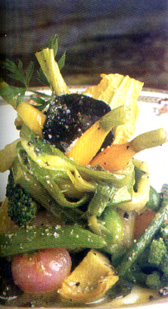 Vegetables from the Gardens of Provence
Vegetables from the Gardens of Provence
Ingredients:
12 baby carrots with tops
12 baby turnips with greens
4 artichokes
4 zucchini flowers
4 fennel
8 leeks
8 radishes
17 oz. baby peas
17 oz. broad beans
3 1/2 oz. string beans
8 asparagus tips
1 oz. black truffles
Dash of aged balsamic vinegar from Modène
Dash of aged vinegar from Xérès
2 fluid oz. fond blanc (chicken)
Dash of olive oil
Fleur de sel
Sea salt
3 1/2 oz. pois gourmands
12 scallions
1 lemon
Knob of butter
Mature olive oil
White pepper
Method:
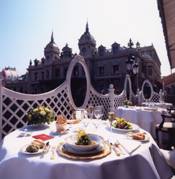 All the vegetables must be washed and dried with great care as they are young and can be easily damaged. Peel the baby carrots and turnips, leave about a 1/4 inch of the tops. Cut the fennel stalks and remove the first layer of skin. Remove the roots and top of the leeks and radishes. Shell the peas and broad beans, remove the stalks of the string beans. Remove the pistil from the zucchini flowers. Remove the leaves of the artichokes then the choke. Cut in quarters and place in water with a little lemon juice. Cut the asparagus (you should keep about 3" of the tip). Cook the peas, broad beans and asparagus individually in a casserole of boiling salty water. Remove the vegetables from the water while they are still firm and cool by dipping quickly in chilled water. Leave to drip dry and cool on a perforated metal sheet.
All the vegetables must be washed and dried with great care as they are young and can be easily damaged. Peel the baby carrots and turnips, leave about a 1/4 inch of the tops. Cut the fennel stalks and remove the first layer of skin. Remove the roots and top of the leeks and radishes. Shell the peas and broad beans, remove the stalks of the string beans. Remove the pistil from the zucchini flowers. Remove the leaves of the artichokes then the choke. Cut in quarters and place in water with a little lemon juice. Cut the asparagus (you should keep about 3" of the tip). Cook the peas, broad beans and asparagus individually in a casserole of boiling salty water. Remove the vegetables from the water while they are still firm and cool by dipping quickly in chilled water. Leave to drip dry and cool on a perforated metal sheet.
 Heat a dash of olive oil in a large pot (the pot should be large enough that vegetables are not really be pilled on top of each other) and add all the remaining vegetables (except the radishes which will be cooked in the same manner but separately, as they tend to discolor). Add a little salt to the vegetables, cover the pot with a lid and leave to simmer for a while. When the moisture from the vegetables has evaporated, add the fond blanc, just enough to nearly up to the same level as the vegetables and leave to cook stirring gently from time to time.
Heat a dash of olive oil in a large pot (the pot should be large enough that vegetables are not really be pilled on top of each other) and add all the remaining vegetables (except the radishes which will be cooked in the same manner but separately, as they tend to discolor). Add a little salt to the vegetables, cover the pot with a lid and leave to simmer for a while. When the moisture from the vegetables has evaporated, add the fond blanc, just enough to nearly up to the same level as the vegetables and leave to cook stirring gently from time to time.
When the vegetables are nearly cooked, remove the lid and add the lightly cooked green vegetables, crushed black truffle, olive oil, a knob of butter. Leave to simmer until the previously firm vegetables are cooked to your liking, and the flavor of the truffle mixes with the vegetables and sauce, which will be by then much thicker. Gently place the vegetables on the serving plate (preferably a deep dish) and keep the sauce on the side. Add the balsamic vinegar from Modène and the Xérès vinegar to the sauce, check the seasoning and pour generously over the vegetables. Add a drizzle of olive oil and fleur de sel and serve immediately.
(Serves 4)
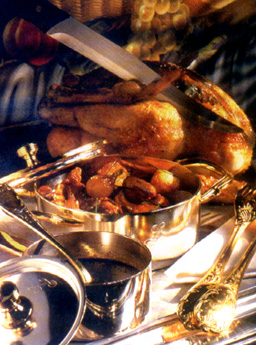 Spit Roast Chicken with Herbs & Garden Vegetables
Spit Roast Chicken with Herbs & Garden Vegetables
Ingredients:
1 chicken (cleaned) 4 1/2 lbs.
Ingredients for the filling or sauce:
10 1/2 oz. butter
1 shallot
7 oz. white mushrooms
1 bunch of Italian parsley
1 bunch of chervil
Sprig of tarragon
Chives
1 head of garlic
4 c. chicken juices
Salt and freshly ground pepper
Progression:
Cream 7 oz. of butter. Chop the herbs (3/4 of the parsley, 3/4 of the chervil, the sprig of tarragon) and mix with the creamed butter. Keep just the tips of the remaining parsley and chervil. Clean the white mushrooms and dice (quite small), bake them slowly in butter and add to the herbed butter and the finely sliced shallots. Season with pepper and salt.
Lift the skin slightly from the chicken, without tearing it, and spread the herbed butter underneath. Be careful afterwards to ensure that the skin covers the meat so that it does not dry out during cooking. If you do not have a spit you can cook the chicken in the oven at 350F for about 1 _ hours. When the chicken is 3/4 cooked, deglaze with chicken juices. When cooked, sieve the cooking juices and add the chervil and parsley. This will be used later on.
Onions:
12 white onions (average size)
1 T. ricotta
1 T. parmesan
1 T. chopped Italian parsley
1 small stick of celery
2 t. grilled pine nuts
1 t. salted pork fat
2 T. roasted chicken juices
A little chopped sage
Olive oil
Salt & white pepper
Method:
 Peel and wash about 8 white onions; remove the top of the onions (about 1/2 of onion if it is small or 1/3 if it is large, these lids will be used later on), empty the middle of the onions with a spoon (keep two or three layers of onion).
Peel and wash about 8 white onions; remove the top of the onions (about 1/2 of onion if it is small or 1/3 if it is large, these lids will be used later on), empty the middle of the onions with a spoon (keep two or three layers of onion).
Dice the other onions finely with the spooned out interiors. Sweat the onions in olive oil until they are lightly golden, add salt and pepper. Cut the celery stick into very small pieces, and crush the grilled pine nuts with a knife (you can grill them in the grill or oven). Away from the heat mix the sweated onions, diced celery, pine nuts, ricotta, the salted pork fat, sage, parmesan, chopped parsley, salt and pepper.
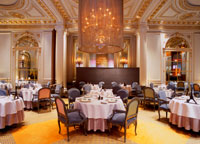 Stuff the onions (replace the tops on the onions before cooking) and put them on a baking sheet, drizzle with olive oil and cook in the over preheated to 356F for near _ hour. Be careful not to burn them, if you think there is a risk of burning cover them with kitchen foil. Baste the onions regularly in their juices as this will make them really tasty and fondant (slightly melted). When the onions are cooked, coat them with chicken juices, add freshly ground pepper and serve.
Stuff the onions (replace the tops on the onions before cooking) and put them on a baking sheet, drizzle with olive oil and cook in the over preheated to 356F for near _ hour. Be careful not to burn them, if you think there is a risk of burning cover them with kitchen foil. Baste the onions regularly in their juices as this will make them really tasty and fondant (slightly melted). When the onions are cooked, coat them with chicken juices, add freshly ground pepper and serve.
Tomatoes:
16 ripe tomatoes
20 tomato quarters confit (remove the pips and interior)
4 white onions (not to big)
1 T. chopped parsley
1 T. ground basil
1 T grated parmesan
2 T. chicken juices
4 cloves of garlic (unpeeled)
1 sprig of thyme
1 sprig of rosemary
Olive oil
Salt & pepper
Method:
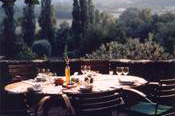 Cut the top off 8 tomatoes (about 1/3 of the tomato) and keep the stalk part to use as a cover on the stuffed tomatoes. Salt and pepper the interior of the tomatoes and leave upside down on a baking sheet to drain out excess water. This will give you a more solid tomato and it will avoid excess liquids in the stuffing. Remove the skin from the remaining tomatoes (leave them a few seconds in boiling water); cut into quarters and remove the insides.
Cut the top off 8 tomatoes (about 1/3 of the tomato) and keep the stalk part to use as a cover on the stuffed tomatoes. Salt and pepper the interior of the tomatoes and leave upside down on a baking sheet to drain out excess water. This will give you a more solid tomato and it will avoid excess liquids in the stuffing. Remove the skin from the remaining tomatoes (leave them a few seconds in boiling water); cut into quarters and remove the insides.
 Chop the tomato confit into roughly diced sized pieces. In a cast iron pot, heat the olive oil with the unpeeled garlic cloves, add the peeled and emptied tomatoes, rosemary sprig, salt and pepper and leave to cook in a hot oven (390F) until you obtain a fondant marmalade appearance.
Chop the tomato confit into roughly diced sized pieces. In a cast iron pot, heat the olive oil with the unpeeled garlic cloves, add the peeled and emptied tomatoes, rosemary sprig, salt and pepper and leave to cook in a hot oven (390F) until you obtain a fondant marmalade appearance.
Once the marmalade is cooked and cooled, remove the garlic cloves, thyme and rosemary, then add the finely chopped white onions and sweat with olive oil. Mix together the chopped tomatoes confit, parsley, grated parmesan and chopped basil. Drizzle with a little olive oil, and check the seasoning, you may have to add a little salt and pepper.
 Stuff the tomatoes with both mixtures and cover with the tomato stalk tops, then place them in a gratin dish and sprinkle with olive oil. Place in an oven, preheated to 350F, for half an hour. Sprinkle regularly with olive oil and the roasted chicken juices. Serve the tomatoes and onions on the plate, carve the chicken and coat with the jus. Add a little freshly ground pepper and drizzle with chives cut lengthwise. You can add other vegetables, such as artichokes cooked whole (cooked barigoule style) then stuffed with olive tapenade, braised with the tomatoes in the oven with the chicken juices. A few croutons rubbed with garlic and pan-fried are perfect to finish the dish.
Stuff the tomatoes with both mixtures and cover with the tomato stalk tops, then place them in a gratin dish and sprinkle with olive oil. Place in an oven, preheated to 350F, for half an hour. Sprinkle regularly with olive oil and the roasted chicken juices. Serve the tomatoes and onions on the plate, carve the chicken and coat with the jus. Add a little freshly ground pepper and drizzle with chives cut lengthwise. You can add other vegetables, such as artichokes cooked whole (cooked barigoule style) then stuffed with olive tapenade, braised with the tomatoes in the oven with the chicken juices. A few croutons rubbed with garlic and pan-fried are perfect to finish the dish.
For more information, contact 212.265.7300 or go to www.alain-ducasse.com
To read more articles by well known writer, Kaya Morgan , click the link.

All rights reserved ©

With respect to the articles and their subject matter, it is based on information provided through research and/or by the interviewed parties and is not based on any original ideas or opinions of the author.
Press Coverage | Cash Flow Solutions | VentureCapital | Business Development | Venture Opportunities | Resources | Contact Us | Investor Extras | Home